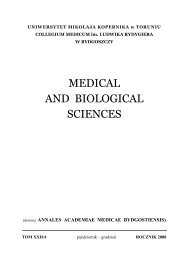Wsparcie spoÅeczne u chorych z miażdżycÄ tÄtnic koÅczyn dolnych
Wsparcie spoÅeczne u chorych z miażdżycÄ tÄtnic koÅczyn dolnych
Wsparcie spoÅeczne u chorych z miażdżycÄ tÄtnic koÅczyn dolnych
Create successful ePaper yourself
Turn your PDF publications into a flip-book with our unique Google optimized e-Paper software.
16<br />
Paweł Sutkowy et al.<br />
present in a diet, have anti-inflammatory properties<br />
[27].<br />
High-reactivity molecules such as ROS have also<br />
crucial importance for correct functioning of locomotor<br />
system. During a rest, free radicals are produced into<br />
muscles as a consequence of activity of the<br />
mitochondrial electron transport. Inside of working<br />
muscles, capillary endothelial enzymes (xanthine<br />
oxidase, nitric oxide synthase – NOS), phospholipase<br />
A2 and in the myocardium NADH oxidoreductase are<br />
responsible for their additional production. This way,<br />
generated reactive oxygen species such as:<br />
• NO,<br />
ONOO – , O •− 2 and • OH, significantly contribute to the<br />
achievement of maximum force of the muscle<br />
contraction and increase strength of tetanic<br />
contractions of the muscle [4].<br />
In the human organism nitric oxide and other N-<br />
centered radicals which create reactive nitrogen species<br />
group (RNS) are particularly important [2]. • NO was<br />
described as endothelium-derived relaxing factor<br />
(EDRF) that plays an important role in the regulation<br />
of blood pressure [28]. It is also significant<br />
neurotransmitter [2] and takes part in regulation of the<br />
activity of NF-kappaB [25, 26]. Moreover, the nitric<br />
oxide-derived radicals may nitrosate and oxidize<br />
tyrosine residues of proteins and affect their<br />
phosphorylation, thus they can modulate activities of<br />
enzymatic proteins [29]. The next important function<br />
of RNS is to destroy pathogens in the process named<br />
the respiratory burst of phagocytes (neutrophils,<br />
macrophages and monocytes) [30]. The respiratory<br />
burst is initiated by creation of active complex of an<br />
enzyme – the NADPH oxidase. This enzyme is<br />
activated due to numerous mediators which include<br />
cytokines, which react with a suitable receptor on the<br />
surface of the cell. It allows production of superoxide<br />
anion (O •− 2 ) as a result of displacement of an electron<br />
•−<br />
from NADPH to molecular oxygen (O 2 ). Created O 2<br />
undergoes a dismutation to hydrogen peroxide (H 2 O 2 ).<br />
The dismutation reaction is catalyzed by superoxide<br />
dismutase (SOD) but may also be spontaneous. In the<br />
presence of ferrous ions hydroxyl radicals ( • OH) are<br />
produced and due to an action of myeloperoxidase a<br />
hypochlorous acid (HOCl) is formed that can react<br />
with amines to form chloramines. The high activity of<br />
inducible nitric oxide synthase (iNOS) inside of<br />
activated phagocytes is another source of antibacterial<br />
agents. Initially, a created nitric oxide (NO) reacts with<br />
•−<br />
O 2 and a highly bactericidal peroxynitrite (ONOO – )<br />
is produced. The nitric oxide in high concentrations has<br />
also antiseptic properties [28-30].<br />
Reactive oxygen species (ROS), including oxygen<br />
free radicals (OFR), play a significant role in a<br />
regulation of proper functioning of human organism.<br />
Still more facts show that inside of the human body<br />
ROS are produced continuously and their<br />
concentrations are tightly controlled by intra- and<br />
extracellular antioxidants.<br />
REFERENCES<br />
1. Bartosz G.: Druga twarz tlenu. PWN, Warszawa, 2009.<br />
2. Bobrowski K. Free radicals in chemistry, biology and<br />
medicine: contribution of radiation chemistry.<br />
Nukleonika 2005; 50(3): 67-76.<br />
3. Ziemlański Ś, Wartanowicz M. Rola antyoksydantów w<br />
stanie zdrowia i choroby. Pediatr. Współcz.<br />
Gastroenterol. Hepatol. Żywienie Dziecka 1999; 1(2/3):<br />
97-105.<br />
4. Clanton et al. Evidence for ROS production in skeletal<br />
muscle. P.S.E.B.M. 1999; 222: 253-262.<br />
5. Sutkowy P. Wpływ jednorazowej kriostymulacji<br />
ogólnoustrojowej na stężenie dialdehydu malonowego<br />
(MDA) i drobnocząsteczkowych antyoksydantów we<br />
krwi osób amatorsko uprawiających sport. Uniwersytet<br />
Mikołaja Kopernika, Collegium Medicum im Ludwika<br />
Rydygiera w Bydgoszczy. Praca magisterska, Toruń<br />
2010.<br />
6. Schafer FQ, Buettner GR. Redox environment of the cell<br />
as viewed through the redox state of the glutathione<br />
disulfide/glutathione couple. Free Radic Biol Med 2001;<br />
30(11): 1191-212.<br />
7. Burdon RH. Superoxide and hydrogen peroxide in<br />
relation to mammalian cell proliferation. Free Radic Biol<br />
Med 1995; 18(4): 775-794.<br />
8. Suzuki YJ, Forman HJ, Sevanian A. Oxidants as<br />
stimulators of signal transduction. Free Radic Biol Med<br />
1997; 22(1-2): 269-285.<br />
9. Sun Y, Oberley LW. Redox regulation of transcriptional<br />
activators. Free Radic Biol Med 1996; 21(3): 335-348.<br />
10. Allen RG, Tresini M. Oxidative stress and gene<br />
regulation. Free Radic Biol Med 2000; 28(3): 463-499.<br />
11. Arrigo AP. Gene expression and the thiol redox state.<br />
Free Radic Biol Med 1999; 27(9-10): 936-944.<br />
12. Chandra J, Samali A, Orrenius S. Triggering and<br />
modulation of apoptosis by oxidative stress. Free Radic<br />
Biol Med 2000; 29(3-4): 323-333.<br />
13. Gardner AM et al. Apoptotic vs. nonapoptotic<br />
cytotoxicity induced by hydrogen peroxide. Free Radic<br />
Biol Med 1997; 22(1-2): 73-83.<br />
14. Vogt W. Oxidation of methionyl residues in proteins:<br />
tools, targets, and reversal. Free Radic Biol Med 1995;<br />
18(1): 93-105.<br />
15. Monteiro HP, Stern A. Redox modulation of tyrosine<br />
phosphorylation-dependent signal transduction pathways.<br />
Free Radic Biol Med 1996; 21(3): 323-333.

















